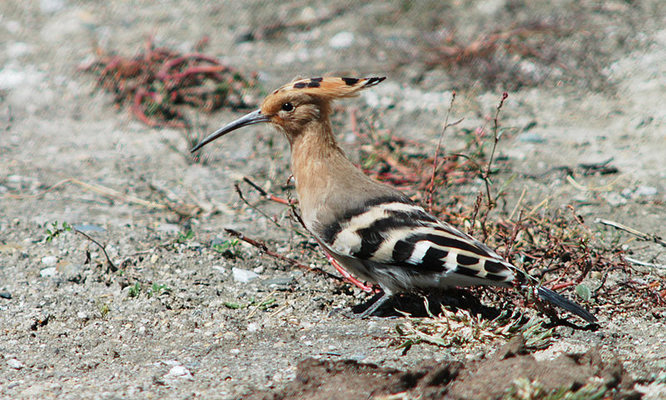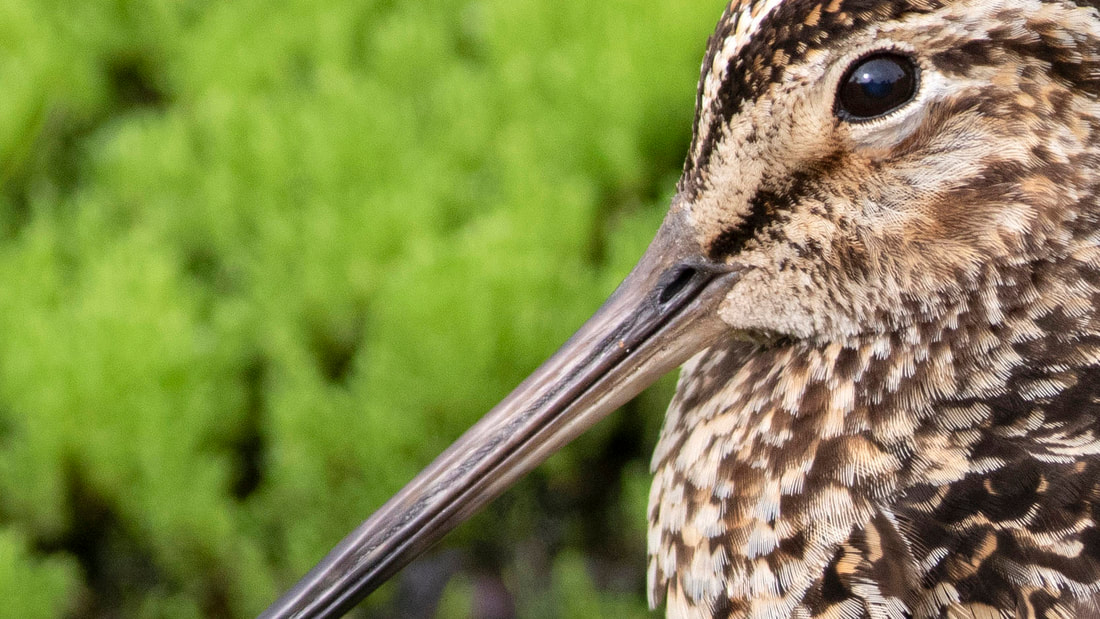|
Our plan to leave for the mountains northeast of Lhasa has been delayed one day. Today we had to pick up Chitra from Nepal at the airport. He is going to join us the coming days. Delays and bad communication made us spend the day whole on the road back and fourth to Gonggar, as well as six hours waiting at the airport. Anyway, birding around Lhasa airport (Gonkar) was not bad at all. Finally I got to study the Oriental Turtle Dove well in the telescope (see the tailshot below: the characteristic dark smudging on the outer web of the outer tailfeather). Despite being common this species usually hide in dense trees, or just fly by. We also found a Grey Wagtail in a small waterdike along the fence of the airport - the first of the trip. The ride back to Lhasa did also give several new trip-species along the river. A nice group of about forty Ruddy Shelducks was an appreciated sight. When stopping to have a piss we flushed a flock of fifty White-rumped Snowfinches. The first snowfinches of the trip. Total list from today: Ruddy Shelduck (40), Mallard (20), Goosander (25), Hoopoe (common), Hill Pigeon (40+), Oriental Turtle Dove (20), Green Sandpiper (2), Common Sandpiper (1), Great Black-headed Gull (25+), Brown-headed Gull (5), Common Buzzard (3), Common Kestrel (5), Greay-backed Shrike (15), Black-billed Magpie (10), Black Redstart (5), Great Tit (5), Eurasian Crag Martin (30), Dusky Warbler (2), Tickell’s Leaf Warbler (3), Oriental Skylark (4), Eurasian Tree Sparrow (common), White-rumped Snowfinch (50), Grey Wagtail (1), White Wagtail (50), Olive-backed Pipit (5) and Twite (25).
We started the day by spending a few hours at Shanga, five km. east of Lhasa. This was Tserings study area for his master thesis. His master dealt with the breeding ecology of the Grey-backed Shrike (also referred to as Tibetan Shrike - see photo of a first-winter bird below). There were still lots of them around, both adults and first winter birds. Normally the Grey-backed Shrike migrates to the Indian subcontinent during September and October, with some late youngsters lingering in November. The shrikes spent lots of time on the ground, searching for beetles and other insects. The location is forested (planted) with different species reaching up to ten meters above ground level. Other good species in the woods were amongst others Dusky Warblers and Tickell's Leaf Warblers, with about thirty of each. Both species were calling a lot, and the Tickell's did actually also sing quite a bit. Two Olive-backed Pipits gave brief views in the woods. At the southern part of the area, the dried out river came in. Some water pits made a good habitat for wagtails, and both Citrine and White Wagtails were present. I also got my first views of the only natural rodent here, the hyperactive Pica. The Pica is a small animal, looking like something in between a mouse and rabbit. The rest of the day was spent at the foothills of Pagar, 35 km. east of Lhasa. The area has lots of canyon-like formations which ends up in agricultural land. Many of passerines were present here. Mixed parties of the stunning Brown Accentor, Godlewski's Buntings, Twites, Russet Sparrows and some Common Rosefinches fed on seeds from some kind of plant. We were sitting behind some rocks, and got excellent views of the birds. Nearby we came over two family-groups of Hume's Groundpeckers (also called Tibetan Ground-jay or Ground Tit). This is a small passerine, about the size of a Wheatear, with an amusing behaviour and look. It is mostly sandy grey with a brownish cap, and has a quite long decurved bill. Looking like nothing I've ever seen before. See a picture of this amuzing species and its habitat here. When we were about to leave we flushed a Little Owl in front of us. Tsering could tell me that it was a rare bird in the Lhasa valley, and he had never encountered the species before here. The area was filled with Picas running around, and we got excellent views of an Himalayan agama lizard (which is the largest of three different lizard species in this part of Tibet). Total list from today: Common Hoopoe (30+), Little Owl (1), Hill Pigeon (30), Oriental Turtle Dove (5), Redshank (1), Great Black-headed Gull (1), Eurasian Sparrowhawk (1), Common Buzzard (1), Eurasian Kestrel (3), Grey-backed Shrike (30), Black-billed Magpie (2), Hume?s Groundpecker (10), Red-billed Chough (2), Eurasian Blackbird (10), Black Redstart (8), Common Stonechat (1), Great Tit (5), Eurasian Crag Martin (4), Dusky Warbler (30), Tickell's Leaf Warbler (30), Yellow-browed Warbler (2), Oriental Skylark (10), Russet Sparrow (10), Citrine Wagtail (10), White Wagtail (10), Olive-backed Pipit (2), Brown Accentor (25), Twite (40), Common Rosefinch (2) and Godlewski's Bunting (15).
Species list for Shanga and Pagar.
Just outside the centre of Lhasa lies the wetland Lalou Dhamra. Today we carried out a census in parts of this 6.4 square km area, in a rather relaxed tempo. The altitude is still lingering in my head...
Just before entering the site we had two Grey-backed Shrikes along the road. When parking the car on the northern side of the wetland, several Citrine Wagtails and Hoopoes welcomed us. Citrine Wagtails and Oriental Skylarks were the most typical and numerous species today. Also very rewarding was three Himalayan Griffon Vultures soaring above the hills. This is the species that the Tibetan people use for their sky burials. Apparently there was a dead Yak in the mountains, and I guess the Vultures were dribbling for a bite of that one. Two Red-billed Choughs were also a new experience for me, as were some Russet Sparrows in a group of Eurasian Tree Sparrows. The local varieties of birds include Black Redstarts of the subspecies rufiventris and Twites (subspecies rufostrigata). The White Wagtails are a fine mixture of the subspecies leucopsis and alboides.
Total list from Lalou Dhamra: Common Hoopoe (25+), Hill Pigeon (20), Oriental Turtle Dove (5), Redshank (3), Great Black-headed Gull (5), Brown-headed Gull (5), Himalayan Griffon Vulture (3), Common Kestrel (2), Grey-backed Shrike (2), Red-billed Chough (2), Black Redstart (3), Asian House Martin (4), Oriental Skylark (35+), Russet Sparrow (3), Eurasian Tree Sparrow (10), Citrine Wagtail (30), White Wagtail (20) and Twite (15).
The flight from Beijing to Lhasa went well, and Tsering from the Tibet University met me at the airport. The drive from the airport to Lhasa took about an hour, and we did see several good birds on the trip. The cracking Ibisbill was the ultimate one (about ten birds seen), but several Great Black-headed Gulls, Brown-headed Gulls, Hill Pigeons and Oriental Turtle Doves made the drive even more noteworthy. When we arrived at the hotel in Lhasa I finally could say hello to the altitude. Suddenly all the blood from my head felt like it was drained out, my heart was pounding like hell, and I had to sit down. My body felt totally exhasted... We calmed down over a cup of tea before going out to eat at a restaurant. I had read that the extraordinary butter tea was good for altitude sickness, and drank at least a litre of it. Butter tea is made out of Yak butter, tea, water and salt. A special taste for a Norwegian, but not bad at all. Despite consuming lots of it, I had great problems sleeping during the night. I didn't have any headache, but I felt an intense pressure inside the head. Nevertheless, during the next day I felt fine again. Day number two in Lhasa was spend for shopping and watching attractions in this extremely nice city, including the huge Potala Palace (where the Dalai Lama used to live). Not many birds in the middle of Lhasa, but several White Wagtails and some Asian House Martins were present.
Coming from Norway you have to stop over in Beijing before entering Tibet. I have been in Beijing for three days now, but the birding activity has been put aside so far. Lots of planning and logistics had to be arranged here, before ascending to the heights. Finally, today all the paperwork and permissions were all right, and I could bird for some hours. Recommendations from other Norwegian birders sent me to The Forbidden City and the surrounding parks. The Forbidden City was built in the 14th century, and consists of nearly 1000 buildings. The City is worth many hours of visit. This was probably the most impressive architecture work I ever saw. The parks were also really nice. At least 25 Azure-winged Magpies roamed about in small groups. The first lifer on the trip! Other birds included the numerous Tree Sparrow, some Russet Sparrows four Yellow-browed Warblers, a Great-spotted Woodpecker (female - but I was confused by the bird. It looked like a hybrid between White-backed and Great-spotted... I guess it is the subspecies that show this much white and aberrant features in the face. I'll check it when I get back to some real literature). Furthermore, two Magpies (of another subspecies than ours), and a Thick-billed Crow.
So folks! Tomorrow morning I'm heading for the mountains. See you there ;-) |
StorymapsBlog archive
May 2024
|





















 RSS Feed
RSS Feed
